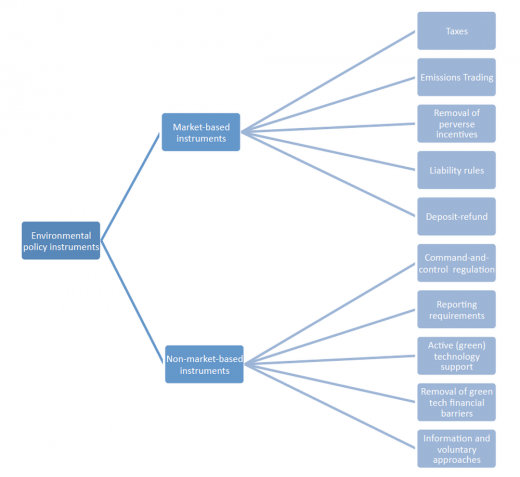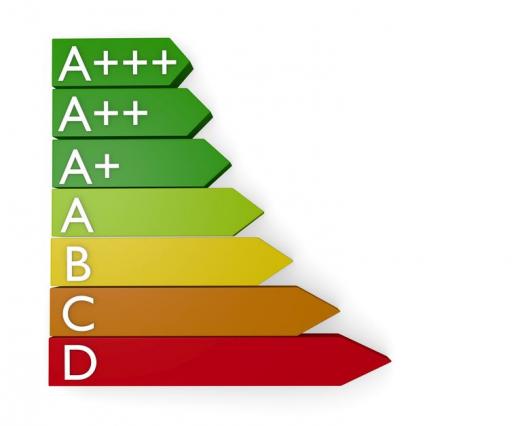Issues:
Sectors:
Keywords:
Within the European Union (EU) there is a mix of climate policies in place. These instruments can be grouped into two different types: non-market based and market-based instruments. The following article explains non-market based instruments in place in the EU, based on a categorisation produced under the research project CECILIA20501. The policy types are illustrated with examples. Information on market-based instruments can be found in the article "Market-based climate policy instruments in the EU". A discussion of both concepts is available in the article "Discussion of climate policy instrument types applied in the EU".
1. Non-market-based instruments
Figure 1 depicts a general taxonomy of climate policy instruments. This section will give a short introduction to each instrument category.
1.1 Command-and-control regulations
Command-and-control instruments impose direct regulatory intervention by setting standards, e.g. of pollution output or technology requirements. In climate change policies, these are mainly connected to greenhouse gas (GHG) emissions or energy efficiency. Standards are usually combined with legal enforcement in the case of non-compliance. They are a very straight-forward way of policy intervention with relative certainty over the environmental effectiveness2. Forms of command-and-control instruments mainly comprise framework, performance and technology standards, as well as prohibition of certain products and practices1.
Performance standards (also referred to as minimum energy performance standards or benchmarks) aim at a specific environmental target without prescribing which technology needs to be used1. An example of a performance standard in the EU is the 2009 regulation on the reduction of CO₂ emissions of new passenger cars3. It sets a certain amount of CO2 that is allowed to be emitted per km (130g/km) by newly produced and registered passenger cars in the EU. This level is aimed to be reduced to 95 g CO2/km by 20204. Thus, producers are forced to produce cars that match these regulations. Another example is the Ecodesign Directive5, which provides EU-wide rules for improving the environmental performance of energy using products, such as household appliances and consumer electronics, as well as on energy related products, such as windows, insulation material etc. Furthermore, building codes and standards set environmental targets in the construction of buildings. Other examples include land use planning and zoning to set environmental targets for land use.
Technology standards prohibit or phase out certain technologies that are environmentally harmful or set minimum standards, e.g. for energy efficiency. The Ecodesign Directive5, for example, introduced EU-wide rules for improving the environmental performance, especially energy efficiency, of energy using and energy related products. These include regulations on standby and off mode of household and office equipment or the phase out of the traditional light bulb.
The Directive on Industrial Emissions (integrated pollution prevention and control) (IED)6, requires that industrial activities with a major pollution potential must meet certain obligations, e.g. reduce emissions, reduce and recycle waste or maximise energy efficiency. One qualitative basis for the assessment under this directive is the framework standard BATNEEC (best available technology not entailing excessive cost) as required by Article 13(1) of the IED, which introduces a moving target on applied technologies and practices, since technological standards and societal values might change.
1.2 Reporting Requirements
Introducing a reporting requirement is a non-market based instrument that is often the basis for future legislation or forms part of other (non-market and market based) instruments. It aims at increasing the level of information available to a governmental body. However, it can also serve to increase awareness, even through the effort of acquiring the additional information, for instance in the case of measuring emissions of an environmental pollutant, which otherwise literally goes out through the chimney without the plant operator taking particular notice1. Reporting requirements are often included into further legislation that accompanies the single policy instruments, such as the Renewable Energy Directive or the Energy Efficiency Directive.
An example is the Monitoring Mechanism Regulation (MMR), setting reporting rules on GHG emissions to meet international requirements and reporting obligations form the 2009 climate and energy package. It helps to keep track of progress towards meeting the Member States’ emission targets for 2013-2020 and thereby facilitates further development of the EU climate policy mix.
1.3 Active (green) technology support
Active green technology support is the public promotion of research and development on green technology or of the adoption of green technology. These instruments focus on the supply side of green technology, as they aim at improving its availability and deployment. Although these instruments involve market elements to a varying degree, they usually involve strong regulatory intervention and have marked technology specifications. Measures include the funding of public and private research, development and demonstration (RD&D), infrastructure funding, and public procurement.
Examples include the NER 300 programme funding innovative carbon capture and storage (CCS) and renewable energy demonstration projects. But also renewable energy support schemes, such as quota obligations or feed-in tariffs belong to this category1.
1.5 Removal of green-tech financial barriers
These are demand side measures to support the use of climate friendly products and practices. Support can be given via tax reductions or tax breaks, capital allowances, direct payments or subsidised loans. This includes examples such as capital allowances for investment in energy efficient equipment in the United Kingdom (UK) or sponsored loans and grants for homeowners who improve their building’s energy efficiency. Also here the instruments incorporate economic incentives but they incentivise highly specific technology applications instead of influencing energy product prices or GHG emissions per se and are therefore listed as non-market-based.
1.6 Information and voluntary approaches
This group of instruments influences the actions of societal actors through their moral sense and by changing the cultural environment. Hence, these instruments influence actors indirectly by means of information, awareness raising and setting of moral standards. Typical examples are product labelling, voluntary agreements with polluters, award schemes or information campaigns7.
Environmental product labelling aims to give consumers access to information on the environmental performance of the product to put them into position to include environmental characteristics in consumption decisions. The labels can contain information on product content, composition, and its origin or production method7. In climate policies the energy performance of products plays an important role. Energy efficiency labels can also provide incentives for industries to develop energy efficient products, as a means of marketing those to consumers as superior to others (based on a more favourable label). However, a prerequisite is that labels are updated regularly to keep up with efficiency advances and also to incentivise them. The energy consumption labelling scheme introduced by the Directive on Energy Labels8 informs consumers on the energy performance of most household appliances, of light bulbs and also cars. The products' energy efficiency is rated in terms of a set of energy efficiency classes.
In the 1990s, voluntary agreements between governments and companies aiming at the reduction of GHG emissions were introduced in various Member States in sectors such as industry, agriculture and transport. In general, signatories of voluntary agreements either committed to carrying out a specific action that is supposed to reduce their environmental impact (e.g. energy audits) or the signatories agree to meet general targets. Tax rebates often play a role in incentivising the signatories to commit to voluntary agreements. Examples of voluntary agreements entail energy audits, benchmarking, action plans and energy management systems9. Often, a voluntary agreement is the first step in tackling a policy problem, where industries are reluctant to change behaviour. The Regulation on car emissions3 is an example, where first voluntary agreements on vehicle emission standards were arranged with the automobile industry, which later were substituted by a regulation.
Public information campaigns can raise awareness of environmental concerns and policy initiatives. European historic examples include "You Control Climate Change" or "A world you like. With a climate you like".


